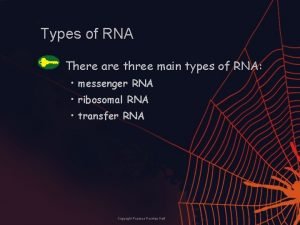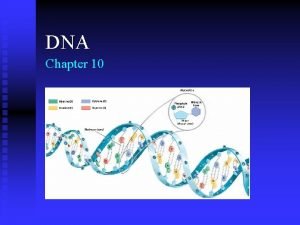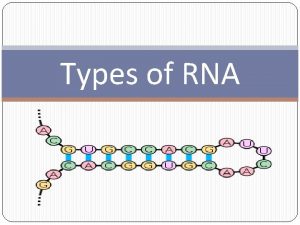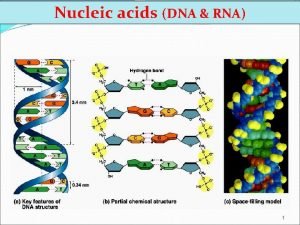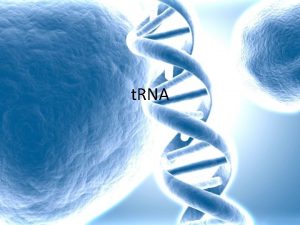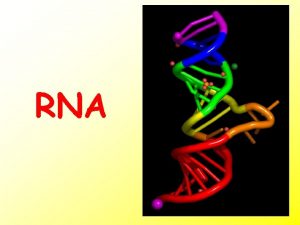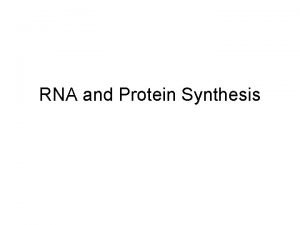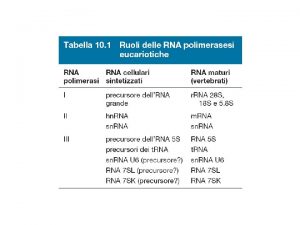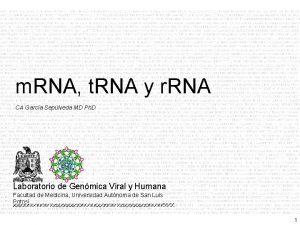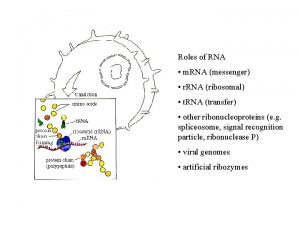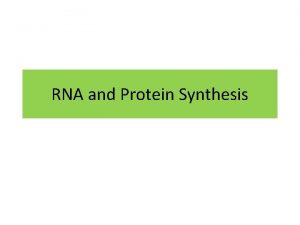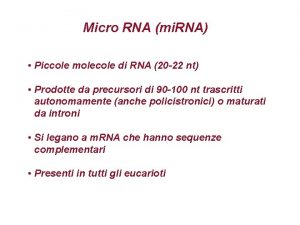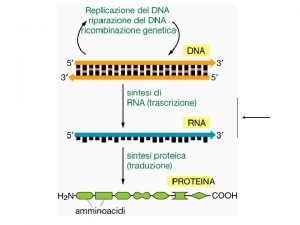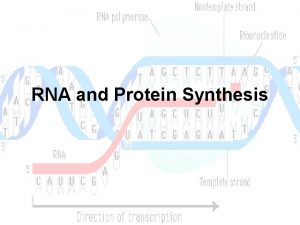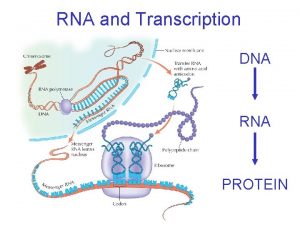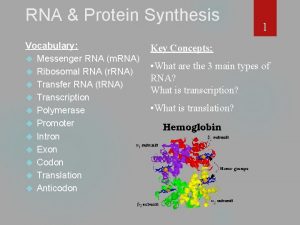Types of RNA Outline RNA Review Main types






















- Slides: 22

Types of RNA

Outline �RNA Review �Main types of RNA �Other types of RNA �References

Outline �RNA Review Main types of RNA Other types of RNA References

RNA Review Ribonucleic acid (RNA) is a polymeric molecule essential in various biological roles in coding, decoding, regulation, and expression of genes. RNA and DNA are nucleic acids

RNA Review Each nucleotide in RNA contains : A ribose sugar, with carbons numbered 1' through 5'. A base is attached to the 1' positaion, in general, adenine (A), cytosine (C), guanine ( G), or uracil (U). . A phosphate group is attached to the 3' position of one ribose and the 5' position of the next

Outline RNA Review �Main types of RNA Other types of RNA References

Main types of RNA In both prokaryotes and eukaryotes, there are three main types of RNA: �messenger RNA (m. RN) �Ribosomal RNA (r. RNA) �transfer RNA (t. RNA)

Main types of RNA 1. Messenger RNA (m. RNA) � m. RNA accounts for just 5% of the total RNA in the cell. � m. RNA is the most heterogeneous of the 3 types of RNA in terms of both base sequence and size. � It carries the genetic code copied from the DNA during transcription in the form of triplets of nucleotides called codons.

Main types of RNA Messenger RNA (m. RNA) … �As part of post-transcriptional processing in eukaryotes, the 5’ end of m. RNA is capped with a guanosine triphosphate nucleotide, which helps in m. RNA recognition during translation or protein synthesis. � Similarly, the 3’ end of an m. RNA has a poly A tail or multiple adenylate residues added to it, which prevent enzymatic degradation of m. RNA. Both 5’ and 3’ end of an m. RNA imparts stability to the m. RNA.

Main types of RNA 2. Ribosomal RNA (r. RNA) �r. RNAs are found in the ribosomes and account for 80% of the total RNA present in the cell. � Ribosomes are composed of a large subunit called the 50 S and a small subunit called the 30 S, each of which has its own r. RNA molecules. � Different r. RNAs present in the ribosomes include small r. RNAs and large r. RNAs, which denote their presence in the small and large subunits of the ribosome.

Main types of RNA Ribosomal RNA (r. RNA) …. �r. RNAs combine with proteins in the cytoplasm to form ribosomes, which act as the site of protein synthesis and has the enzymes needed for the process. � These complex structures travel along the m. RNA molecule during translation and facilitate the assembly of amino acids to form a polypeptide chain. They bind to t. RNAs and other molecules that are crucial for protein synthesis.

Main types of RNA 3. Transfer RNA (t. RNA) � t. RNA is the smallest of the 3 types of RNA having about 75 -95 nucleotides. � t. RNAs are an essential component of translation, where their main function is the transfer of amino acids during protein synthesis. Therefore they are called transfer RNAs. � t. RNAs also act as adapters in the translation of the genetic sequence of m. RNA into proteins. Therefore they are also called adapter molecules.

Outline RNA Review Main types of RNA �Other types of RNA References

Other types of RNA �The other types RNA include : 1. sn. RNA (small nuclear RNA) 2. sno. RNA (small nucleolar RNA) 3. mi. RNA (micro RNA) 4. si. RNA (short interfering RNA) 5. pi. RNA (piwi-interacting RNA) 6. SRP RNA (signal recognition particle RNA)

Other types of RNA 1. sn. RNA (small nuclear RNA): � It is involved with intron splicing and is found in eukaryotes and archaebacteria. � They also regulate transcription factors (proteins that help control DNA transcription) and RNA polymerase II (the polymerase associated with binding to DNA for transcription), and help regulate the length of telomeres. � sn. RNA perform these tasks by forming complexes with certain proteins.

Other types of RNA 2. sno. RNA (small nucleolar RNA) �It helps in the modification of RNA (a majority being r. RNA, t. RNA, and sn. RNA) and is found in eukaryotes and archaebacteria. �A majority of these sno. RNA can be divided into two groups: those involved in methylation (adding methane groups) or those involved in pseudouridylation (it is an isomer of uridine, where uridine is a nucleoside that is composed of a complex of uracil and a ribose sugar).

Other types of RNA 3. mi. RNA (micro RNA) �It regulates gene expression and is found in all eukaryotes except for marine plants, algae, and fungi. �They regulate gene expression by base-pairing with certain m. RNA. By doing so, they can control the m. RNA’s stability and their efficiency of translation.

Other types of RNA 4. si. RNA (short interfering RNA) �It regulates gene expression. �They are foreign double-stranded RNA that are cut into small pieces, and are then incorporated in RISC (RNA-induced silencing complex). �The RISC then uses one strand of si. RNA to find other complementary (and perhaps foreign) RNA to destroy, thereby protecting the cell from potentially dangerous RNA.

Other types of RNA 5. pi. RNA (piwi-interacting RNA): � It regulates the expression of transposons and is found in most animals. �They silence transposons, retrotransposons, and some other genetic elements in the germ cells by keeping the genes from being transcribed. � Most pi. RNA are the antisense of different transposon sequences, which means that they may target these transposons in particular.

Other types of RNA 6. SRP RNA (signal recognition particle RNA): �It helps in transporting proteins through the lipid bilayer membrane of a cell and is found in all cells. � However, they only can control the movement of proteins within the cell, as they are not secreted with the proteins that are transported out of the cell. It also helps sort proteins after translation.

Outline RNA Review Main types of RNA Other types of RNA �References

References �www. presentationszone. com �www. news-medical. net. com �www. biology. knoji. com �www. wikibedia. org
 Carries copies of the instructions for assembling proteins
Carries copies of the instructions for assembling proteins What is rna's main job
What is rna's main job Quote one topic sentence
Quote one topic sentence Ac 120-16
Ac 120-16 Supporting detail 1
Supporting detail 1 Supporting details
Supporting details The main points in a preparation outline are
The main points in a preparation outline are Going to uses
Going to uses What is the central idea of this passage?
What is the central idea of this passage? Void main int main
Void main int main Protein synthesis
Protein synthesis 3 types of rna
3 types of rna Types of rna ppt
Types of rna ppt Nucleic acid dna structure
Nucleic acid dna structure Chapter review motion part a vocabulary review answer key
Chapter review motion part a vocabulary review answer key Writ of certiorari ap gov example
Writ of certiorari ap gov example Narrative review vs systematic review
Narrative review vs systematic review Narrative review vs systematic review
Narrative review vs systematic review Narrative review vs systematic review
Narrative review vs systematic review Two types of main idea
Two types of main idea What is engineering
What is engineering User support
User support 3 types of sentences
3 types of sentences
